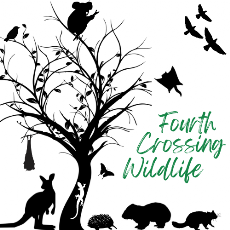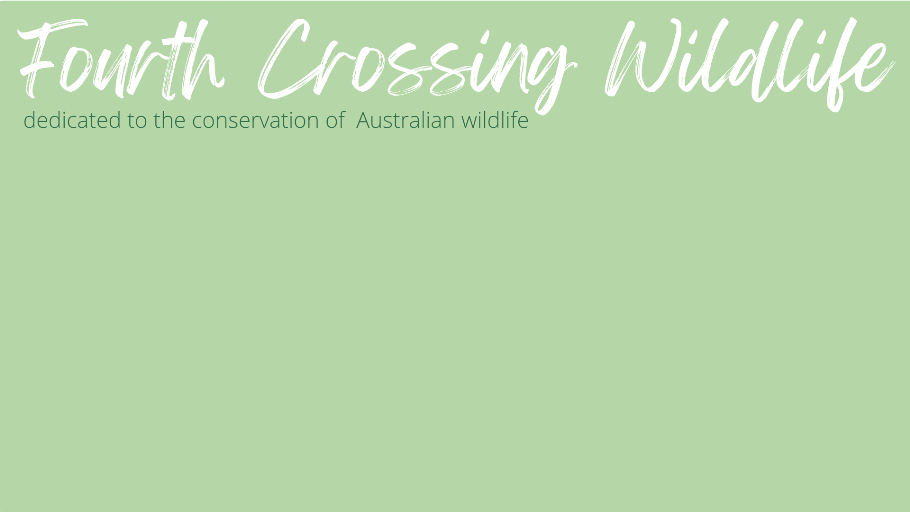Stories
Rescuing the Ringtails
by Linda Dennis
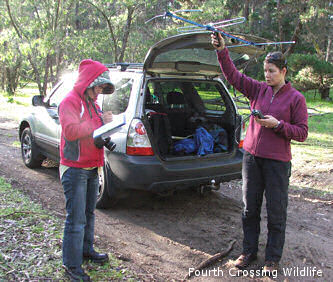 First day of the project, tracking the possums to see who has survived the night. Therese Black (left) and Helen McCutcheon. 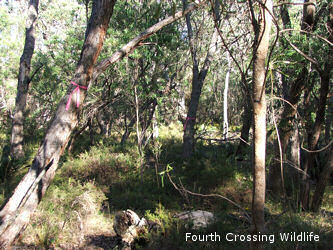 Gelorup Forest - prime Western Ringtail Possum habitat. The pink tags indicate where possums have been seen. 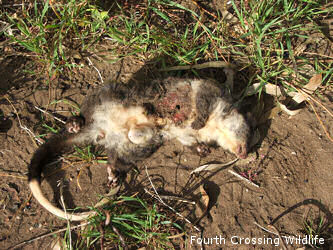 Road kill victim - a common sight in Busselton. 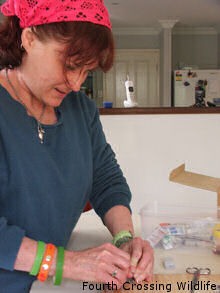 Preparing the sedation darts. 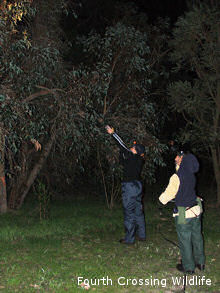 Helen darting a possum. 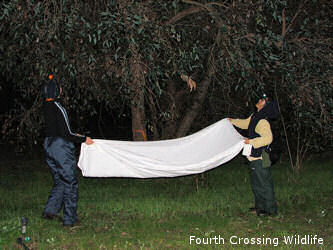 After darting, Helen and Therese wait to capture the falling possum while I hold a spotlight on the possum. 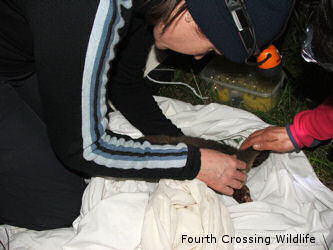 Helen assesses Frodo, our first possum capture. 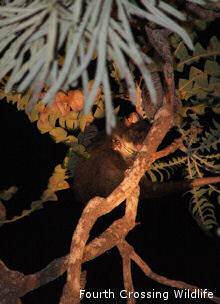 Amelia, a female Western Ringtail Possum. We failed to capture Amelia on the first night. 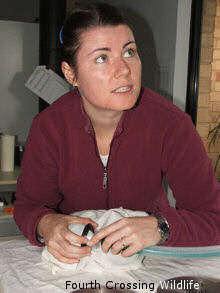 Each possum is assessed the day after capture. In this photo Frodo is being anesthetised for assessment. 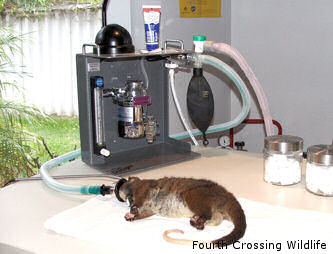 Frodo at the work station. 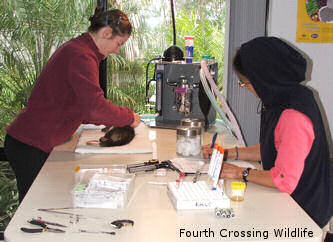 Helen assesses Frodo while Therese scribes. 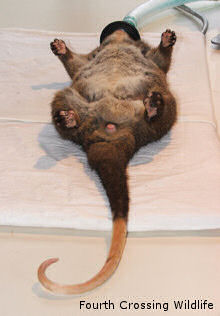 Frodo, chilling out! 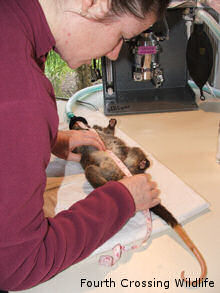 All possums were weighed and measured, collars were removed, labs taken and vital signs monitored. 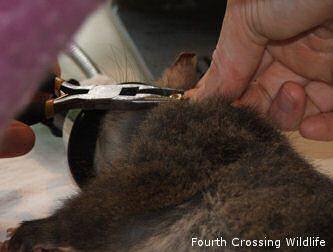 Frodo's collar being removed. 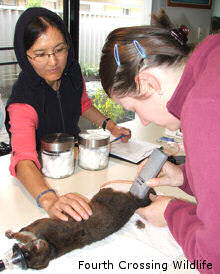 Helen prepares Frodo for blood collection. 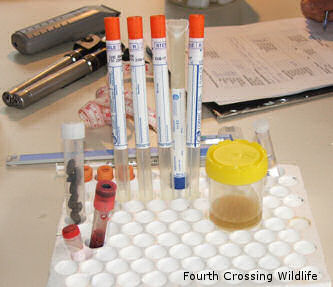 Frodo's labs - blood, eye swabs, saliva swabs, wee and poo. Note that wee is pale in colour due to a diet of mainly Peppermint Gum leaves. 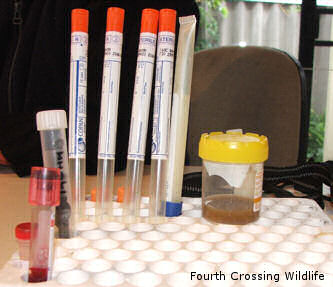 Luna's labs, note the darker coloured wee. 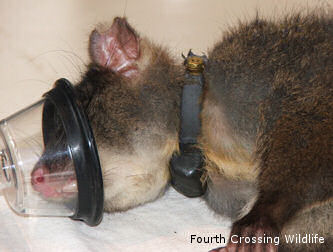 Arwen, a female with twin joeys in the pouch.  There are twins that pouch, but one is hiding! 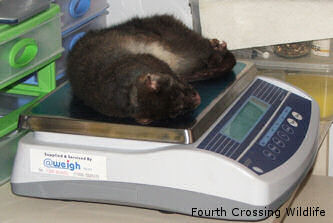 Arwen being weighed. 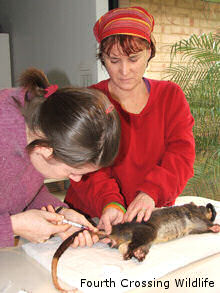 Blood being collected while I hold the vein. 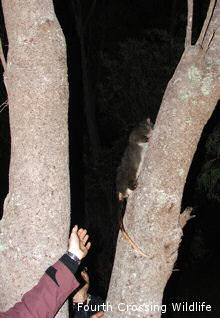 Arwen being released. | After volunteering for the Northern Hairy-Nosed Wombat Recovery Project my friend Therese and I found that we were well and truly hooked on wildlife volunteer projects. There is something very rewarding about helping out on a project that aims to conserve and protect wildlife. So we set about finding a new venture that we could be a part of. After doing a little research on the world wide web we found a project co-ordinated by the Western Australian Murdoch University and the Department of Environment and Conservation. The project was a mortality study on the threatened Western Ringtail Possum. The Western Ringail Possum is classified as vulnerable, listed nationally as a threatened species. Unlike the Eastern Ringtail Possum of NSW (also known as the Common Ringtail Possum) the Western Ringtail is an urban possum living in and around suburban Busselton and some of the surrounding towns. The Western Ringtail Possum's nightly activity is much like that of the suburban Brushtail Possum in NSW. Brushtail Possum's in the Busselton area are more secretive and shy, preferring to stay away from heavily built up areas. It's interesting how the roles seem to be reversed in the two states. The Western Ringtail Possum is under threat due to urban development as more and more new housing developments are constructed and prime habitat is cleared. Sadly, the possum is also sometimes thought of as vermin as it enjoys visiting backyard gardens in search of delicious fruit and flowers, which is generally not tolerated by the public. The possum is also predated on by foxes and feral cats. Due to these threats DEC decided to take action to conserve the species by translocating individuals from habitat before it was cleared and from suburban back yards when complaints were received. Part of the project's aim was to discover if the translocation of the Western Ringtail Possum's was actually working and that's where Helen McCutcheon comes into the story. Helen's study of translocated possums - or at least the "hands on" part of the project - was coming to a close and all the possums involved in the study needed to be recaptured, assessed, have their radio tracking collars removed and released back into their home ranges for the very last time. After discovering the project Therese and I quickly registered our interest with Helen, and were ecstatic when we were accepted as volunteers. Plans were set, plane tickets were booked and before you knew it we were on our way to Busselton, Western Australia, where the project was based. Here is a diary of our time with the possums... Sunday Therese lives in Queensland and I in NSW so Therese flew into Sydney so that we could travel together the rest of the way to Western Australia. When we met at the airport we were like excited little school girls on a big adventure - and so we were! (on a big adventure, that is, not school girls... that was a looooooong time ago!) We flew into Perth late morning and were collected by my dear friend Marg Larner who had a great day planned for us. She took us to her friends cafe in rural outskirts of Perth and we enjoyed a long chat and a great lunch topped off with a glass (or several!) of delicious Western Australian wine. We were then taken on a tour of the estuaries to see Marg's pelican friends. It was terribly cold but we had a lovely day. In the early evening Marg handed us over to Helen and we drove to Busselton where we were to spend the next week working with the Western Ringtail Possums. Monday In the morning we traveled to one of the study sites, the Ludlow Tuart Forest, to carry out a routine mortality check so we could find out which possums had or hadn't survived the night. The tracking collars emitted different pitched frequencies for either "alive and moving" or "dead and still". The possums in this area were keeping their collars on for longer than the rest of the project possums so Helen could continue the study on successful translocation later in the year. Later in our week we would grid an area of the Ludlow Tuart Forest so that the next round of volunteers could carry out a possum count to determine the population in the forest. After dark we headed out to another site at Gelorup and this is where we would be spending most our nights for the rest of the week, tracking and capturing Western Ringtail Possums. Earlier in the day Helen had taken us to the forest for a walk around so that Therese and I could get our bearings and be able to find our way around at night. It didn't work for me! When we started walking through the dark forest I quickly became completely lost and no idea which way I was walking or even where the car had been parked! Luckily Helen knew the area like the back of her hand and guided us easily through the bush. We found and successfully captured Frodo, a male Western Ringtail. Each possum had been given a name and identification number - the volunteers who were involved in the beginning of the study (capturing and applying the collars) were given the honour of naming the individuals. Frodo, even though our first, turned out to be one of the easiest possums to catch. After Frodo had been securely restrained in his calico bag which was placed inside a dark and warm box we set out into the night again. By now, each of us had our own job. Helen was "tracker girl" as she walked up front with the antenna following the sounds of the radio collars. Then there was "dart girl" - Therese who very gently carried the box of pre-made sedation darts (one trip and the mechanism inside the darts would be triggered resulting in useless darts and a wasted night). And then there was me - "gun girl". I carried the dart gun ready for Helen. As luck would have it the gun also served as an excellent spider web remover. Next we found Amelia. Over the course of the study Helen had become an excellent marksman but every now and then a dart would go skimming past the target possum (they are rather small critters with rather small behinds!) and into the forest floor. It would then take us several minutes to find the dart that was fitted with reflective tape, three head torches sweeping amongst the leaf litter until one of us yelled "found it". That was the 'un-fun' part of the night. When Helen aimed for Amelia's tiny butt the dart skimmed, lodged but was then scratched out and it fell to the ground. While Helen kept a close eye on Amelia for signs that the sedative had worked Therese and I busied ourselves looking for the stray dart. After some time it was apparent that Amelia had not received enough sedative to render her unconscious and she kept a firm hold on the branch, glared at us rather rudely, then slowly moved higher up the tree out of reach and curled up in a fork for a short sleep. We continued to watch her for a while but decided to abort our mission after she began to stir as she was too high for a second attempt. In the early hours of the morning we'd had enough - we were tired, cold and hungry so we headed back to the lab-come-volunteers-quarters for a few hours of sleep. Tuesday Each possum is assessed the morning after capture, so for the first task of our second day we processed Frodo. While still safe and snug inside his calico bag Helen anaesthetised him ready for the procedure. This was Therese's and my first up-close-and-personal experience with a ringtail possum so it was an exciting time. As with all the possums in the study, Frodo was weighed and measured and labs were taken, including blood, urine and faeces, eyes swabs and saliva swabs, and then finally the tracking collars were removed. Frodo was then placed in recovery where he was slowly returned to consciousness. He was then left to sleep for the rest of the day. After dark we returned to the forest. We released Frodo back to his home and our next mission was a mortality check on Amelia to make sure she was OK. She was perfectly fine but sitting high in a tree way out of reach - maybe she knew we'd be back? - so we left her and we went in search of another possum. After a while we found Merlin and we set up our capture equipment. Unfortunately we failed to secure Merlin as it was cold, wet and windy and the conditions were not great for darting possums. So the night ended early and we got to bed not long after midnight. Wednesday Our third night out was quite successful, even if our first capture attempt proved not to be - Kiri, a female, was skimmed by the dart which made her a little sleepy but not enough for capture. We then went back to find Merlin. After the failed attempt to capture him the night before, we were determined to get him this time. We set up our equipment and then for the next hour and a half we watched, we waited, we attempted to dart, we cursed as Merlin was a quick mover and then we waited some more. We were nearing the end of our perseverance when Helen saw a window of opportunity as Merlin presented his rump to us as if to say "oh all right, let's get this over with!" Once the dart had found its target Therese and Helen stood underneath the spot where Merlin sat in the tree. It was my job to give continual updates on his position in the tree and his state of consciousness. Then, just as he was about to fall I'd yell "now!" and the girls would capture him in the large blanket held out to protect his fall. Merlin was then settled in his bag, and we moved on to the next possum. Igraine, a female, was tracked but found to be too high to capture. We then found Arwen, another female, who turned out to be our easiest capture for the entire week - just 15 minutes to dart and bag! A quick assessment of Arwen showed that she had twin joeys in the pouch! After two successful captures and being well after midnight we returned to the lab. Thursday Arwen was processed first. Knowing just how vulnerable the species are, it was heartening to see the two wiggling joey's the size of jelly beans in Arwen's pouch. Merlin was then processed and both possums were secured and left to sleep for the day. That night, after Arwen and Merlin were released back into their home ranges, we captured Kiri (a female) in 20 minutes. We were getting better working in our team and knew each of our jobs without having to discuss a capture plan. We then tracked Igrain but failed an attempted capture, then Nora, Leelu, and Amelia were found, but all three were too high in the trees. Helen then decided that we would attempt capture of Luna, a twelve month old female possum who was one of last years joey's Female Western Ringtail Possums generally share their mothers home ranges and males tend to venture off to find a new territory. Luna went against this usual trend however and traveled a whopping 1.5 kilometres in the two nights after her first capture when the monitoring collar was applied. Luna was darted quite quickly but it took some time for the sedative to start working. She became very groggy but not enough to release her grip and fall to the open blanket. Helen decided that it was too risky to leave Luna in such a state so out came the extendable pole to aid in the capture and it wasn't long before we had Luna bagged and were on our way home. Friday - our last day Therese and I were a little sad to be working our last day with Helen and the possums - but what a lovely last day it was. Kiri's assessment was first of the day and we were all exciting to see that she had a larger joey in the pouch. As best she could, Helen measured the joeys head which was about 21mm in length. The joey looked plump and healthy so we didn't attempt any more assessment. If it had been a bit bigger, the joey would have been removed from the pouch and properly assessed before being returned to mums warm and dark pouch. Luna also had a joey, another little jelly bean. Helen was very pleased to see that Luna's big move hadn't distressed her at all and she was healthy and content enough to breed. Luna's lab were interesting. The new spot she'd decided to set up home in had primarily Marri Gums and not the Peppermint Gums of the Gelorup forest. As a result her wee was a much darker colour, as you can see in the photos of Frodo's labs and Luna's labs. Just on dark we released Kiri and Luna and we had the pleasure of watching Luna for a while as she sat and watched us. As it was our last night we decided to celebrate our week by going out to dinner and enjoying a glass or two of champagne. We had been successful in capturing and removing the collars of most of the projects possums in the Gelorup forest - there were only a few more for the next lot of volunteers to capture. For me, releasing the possums were the most rewarding experiences of my time helping on the project. Over many months these little possums had been through several captures and assessments and had what must have been very annoying collars on - sometimes science is a harsh mistress! But these little possums took it very well and due to excellent planning by Helen and her team there were very few signs of distress in the animals. Because of their use in the project a wealth of information on this endangered species has been collated and now these animals have an even better chance of being understood, managed - and saved! |
